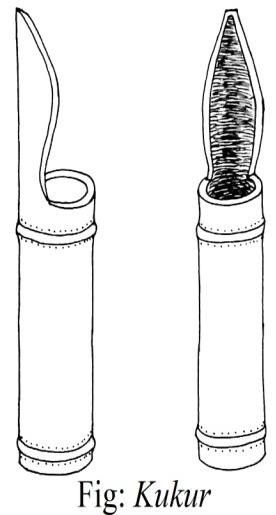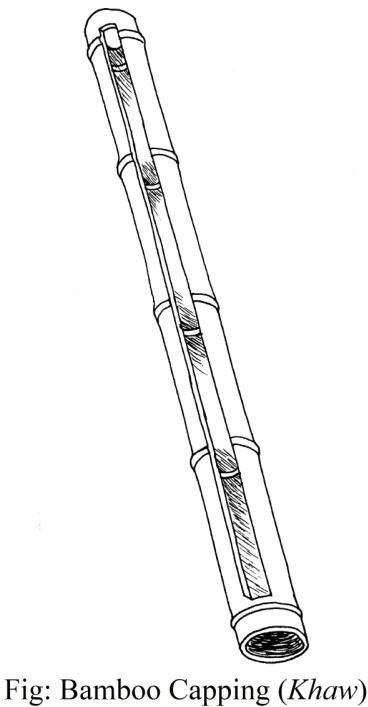Vernacular architecture of Assam
by Nabajit Deka | 2018 | 96,996 words
This study deals with the architecture of Assam (Northeastern India, Easter Himalayas), with special reference to Brahmaputra Valley. The Vernacular Architecture of Assam enjoys a variety of richness in tradition, made possible by the numerous communities and traditional cultures....
Pajaghar Typology (b): Wall Construction
The walls of the traditional houses are primarily made with bamboo or sometime with reed. Three primary techniques or methods of bamboo wall construction are prevalent. In first method, finer bamboo strips / splint known as kathi is used as vertical member and weave through horizontally tied kami. In second method , bamboo split (chuch / soch), prepared from the culm of hollow bamboo, is woven. The chuch is prepared from the jati, bhaluka, and katah varieties of bamboo. The chuch prepared from the katah variety is the regarded as best that lasts up to 20 years.
For making chuch, the upper hollow portion of a bamboo is first intersected as per required height of a wall. Then the piece of the bamboo is rapidly slashed lengthwise with the tang of a chopper or a small hand axe to mesh the bamboo. The whole bamboo piece is thus cracked haphazardly through the strikes of the chopper or axe. Then the bamboo is slit on a side and unrolled to make a flat piece. After unrolling, the diaphragms inside the nodes are removed with an adze. Simultaneously, another weaving member called guri or kami or jilu, i.e. round or flat bamboo splinter respectively, are also prepared which are woven in between the woven chuch at a certain interval.
In the third variety, small varieties of bamboo are flattened in above-mentioned technique, which are then weave on ground in required size. This woven panel is then tied on the wall post with the help of some additional kami. A popular version of such panel is known as tarza, which is widely used in construction.
 While the above-mentioned members are applied as the vertical members, some comparatively broader kamis are tied horizontally to attach or weave them. These kamis are tied firmly to the posts of the house. Simultaneously, immediately below the line of the wall, there embed rows of bamboo member known as kukur. The kukur is a round bamboo piece of about 2 to 3 feet long, sometimes with a sharp bottom-end. Few inches below the top end, the bamboo is fashioned with a step by cutting away two third portion of bamboo so that the step can hold a piece of bamboo. Rows of kukurs are embedded in such a manner that the step cut on the bamboo levels the ground of the plinth and the protruding pillar of the kukur remains outside the wall. After this, a round bamboo known as the garia / goira / geowra / or garania, is placed over the steps of the kukurs that supports the bamboo. Then another member known as the khaw / khabua /mokha or bamboo capping is placed above the previous member. For making a khaw, a strip from a straight and round bamboo is split and removed first and then the joints and diaphragms of the bamboo are removed. This horizontal cleft of the groove receives inside it the bamboo splinters of the wall. The khaw and the garia, fastened to the kukur, keep the wall aloof and prevent from direct contact with soil.
While the above-mentioned members are applied as the vertical members, some comparatively broader kamis are tied horizontally to attach or weave them. These kamis are tied firmly to the posts of the house. Simultaneously, immediately below the line of the wall, there embed rows of bamboo member known as kukur. The kukur is a round bamboo piece of about 2 to 3 feet long, sometimes with a sharp bottom-end. Few inches below the top end, the bamboo is fashioned with a step by cutting away two third portion of bamboo so that the step can hold a piece of bamboo. Rows of kukurs are embedded in such a manner that the step cut on the bamboo levels the ground of the plinth and the protruding pillar of the kukur remains outside the wall. After this, a round bamboo known as the garia / goira / geowra / or garania, is placed over the steps of the kukurs that supports the bamboo. Then another member known as the khaw / khabua /mokha or bamboo capping is placed above the previous member. For making a khaw, a strip from a straight and round bamboo is split and removed first and then the joints and diaphragms of the bamboo are removed. This horizontal cleft of the groove receives inside it the bamboo splinters of the wall. The khaw and the garia, fastened to the kukur, keep the wall aloof and prevent from direct contact with soil.
 After the fastening of the garia and the khaw, the kathi are woven in a wavy pattern through the kamis, tied to the posts beforehand. The bottom ends of the kathis are inserted into the khaw placed below. In between the woven kathis, a guri or kamis or jilu is woven at certain interval that lends strength to the wall. The walls are woven from one side to the other which is further secured using some additional horizontal kamis, especially in the extreme top and bottom end. The corners of the house, where two walls meet, is blocked and joined using a member called pola. The pola is actually a chuch that wraps two walls in the corner to join them. It ensures the closure of the corner gap as well as lends a rounded look to the corner of the houses.
After the fastening of the garia and the khaw, the kathi are woven in a wavy pattern through the kamis, tied to the posts beforehand. The bottom ends of the kathis are inserted into the khaw placed below. In between the woven kathis, a guri or kamis or jilu is woven at certain interval that lends strength to the wall. The walls are woven from one side to the other which is further secured using some additional horizontal kamis, especially in the extreme top and bottom end. The corners of the house, where two walls meet, is blocked and joined using a member called pola. The pola is actually a chuch that wraps two walls in the corner to join them. It ensures the closure of the corner gap as well as lends a rounded look to the corner of the houses.
Along with bamboo, reed is also used for walling the house. To make wall with reed, the reeds are first spread on the ground in one direction between pairs of kamis, and secured tightly, which is subsequently fastened to the wall posts. In another technique, reeds are tied directly to the kamis fastened on the posts. The reed is extensively used in the Assam type house.
